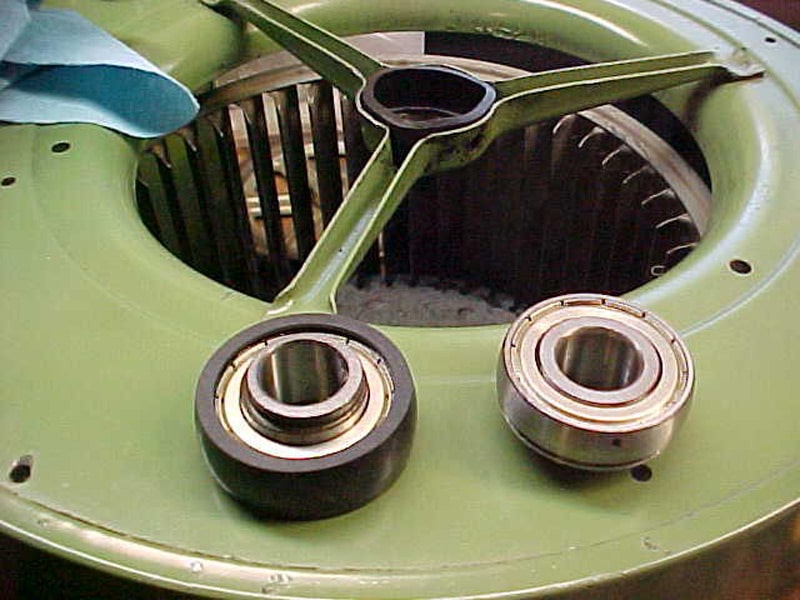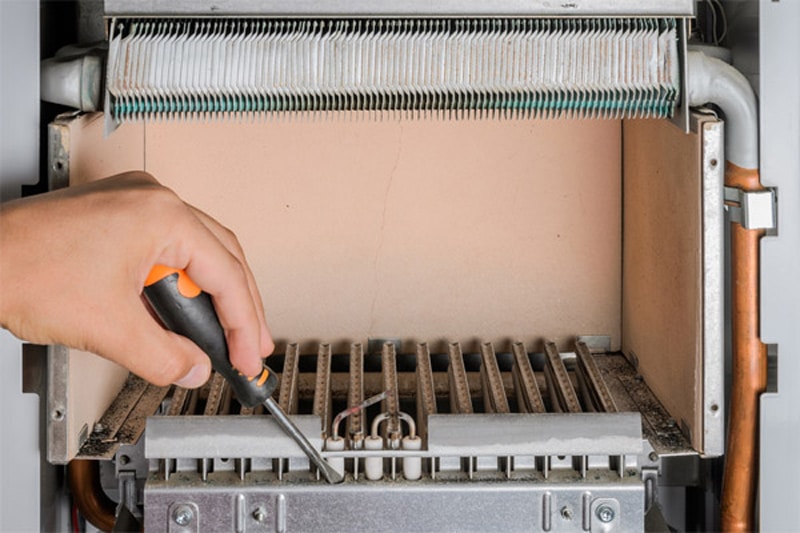We've independently reviewed this article to make sure it's as accurate as we can make it.
To find out more about our article creation and review process, check out our editorial guidelines.
There are a few reasons why your furnace is clicking and unfortunately, most of them are a sign of trouble. And in some cases, the sound is simply a symptom of a more serious issue with your HVAC.
Hopefully, this article will help to identify what’s making the sound and point you in the direction of a solution. So keep reading!
If you’re only hearing your furnace click when you first turn it on, you have no cause for concern, as this is normal. It’s the sound of your ignition starting. However, if you notice that the sound continues, you likely have a more serious problem.
Reasons Why Your Furnace Is Clicking
1. Dirty or Worn Motor Bearings
If your furnace is clicking but otherwise appears to be working normally, one common cause is worn bearings in the blower motor or inducer motor.
If the inducer blowers and fan shafts have a buildup of grime on them or they’ve worn down over time, it can produce a loud clicking sound.
A rusty or dirty shaft in your blower motor may also cause bearings to click.
Solution. In either case, cleaning and lubricating the fan shaft will not only prevent further wear but should also reduce the noise coming from the furnace. Regardless, the situation should be dealt with since worn bearings can lead to your motor burning out.

To lubricate, use two or three drops of 10W non-detergent motor oil without over-lubricating.
2. Loose Inducer Fan
This is another situation where your furnace is working properly but you’re hearing a clicking noise or something similar.
It could be that the inducer fan has become loose, is suffering from general wear and tear, or has a buildup of dust and dirt on the blades.
Solution. Clean the inducer fan motor and blades.
3. Faulty Flame Sensor
If your furnace is clicking but not turning on, then you may have an issue with the thermocouple.
A flame sensor is on a direct ignition furnace and it is connected to a circuit board which can read a certain voltage that is only conducted through a flame.
The clicking sound is a possible indicator that you have a faulty flame sensor that keeps shutting down your furnace.
Solution. Sometimes, all you may need to do is to lightly scrub away any grime or corrosion from your flame sensor. However, if it’s gone bad, flame sensors for a direct ignition furnace (the most common type) can be a little tricky to buy. If you can find one that matches your furnace online, then they aren’t too difficult to replace.
How to diagnose your flame sensor:
- Turn off the power to your furnace
- Shut off the gas valve
- Remove the flame sensor mounting screw
- Gently remove the flame sensor
- Inspect it, looking for any burnt, corroded, or dirty spots. Clean if necessary
- If the porcelain insulation is broken or cracked, you need to replace the sensor
4. Wear & Tear on Pilot Light Assembly
If your older gas furnace with a standing pilot is clicking but not turning on, the culprit may be the pilot light assembly.
Over time, the orifice can get clogged up with dirt and only produce a weak flame. If that happens, the flame doesn’t envelope the thermocouple and it tells your furnace to shut down as a safety measure.
Solution. You’ll need to disassemble the pilot and clean out the orifice. You can do this using a needle, thin wire, or compressed air. This is a job you can do yourself or if you prefer, you can call an HVAC professional.
5. Faulty Ignitor
If your furnace is making a clicking noise and not turning on, it could be your ignitor. However, these tend to only be on older furnace models that use a spark ignition method and a pilot light.
However, if your furnace is clicking and not igniting you may have a loose wire to the ignitor, or it may be clogged.
If you have an older furnace, it may have a standing pilot—this means the pilot light stays lit all the time. Newer furnaces use electronic ignition using either a hot surface ignition method or an intermittent pilot system.

In either case, over time, ignition systems suffer from wear and tear and may need replacement.
Solution. If you have a hot surface ignitor you can try cleaning off the buildup of carbon deposits with compressed air. Be very careful with this – as some of these are very brittle. If that doesn’t work and you need to physically clean it, do the following.
- Power down the furnace
- Disconnect the ignitor wires
- Loosen the screw that holds the ignitor in place and gently lifted out (use a cloth instead of your bare fingers, as the oil on your fingers can damage some types of hot surface igniters)
- Carefully rub the ignitor with fine steel wool, being careful not to damage it
- Replace the ignitor
HVAC Expert: While you can try this cleaning method, in my experience I find that if the ignitor doesn’t light when it gets power from the circuit board, then I’ll need to replace it. No need to spend time cleaning it.
6. Gas Supply Issues
A final sign that may be the cause of a furnace clicking but not turning on is that gas is not reaching the pilot light. The clicking you’re hearing is the ignitor trying to spark a flame.
Solution. You may want to call an HVAC technician for this one. However, replacing the gas valve isn’t too difficult and the part is relatively inexpensive. You can follow the video below for a step-by-step process.
Conclusion
We’ve identified six different reasons that may cause your furnace to click. In some cases, your furnace is running and in others, your furnace doesn’t light up.
To recap, here are the possible reasons:
- Dirty or worn motor bearings
- Loose inducer fan
- Faulty flame sensor
- Wear and tear on pilot light assembly
- Faulty ignitor
- Gas supply issues
If you’re handy, you can fix most of these by yourself. However, if you feel there beyond your capabilities please contact an HVAC professional.
Hopefully, this has helped you diagnose and fix your problem. While you’re here, why not check out some of our related posts below. Perhaps we can help you with something else.







